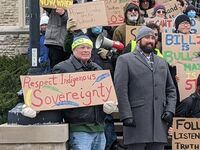How do we mobilize in rural communities/small cities?
Purpose: This page responds to direct requests from rural or small city organizers. Their context presents challenges and opportunities that are unique from urban or larger city environments. Many organizers may feel discouraged by limited turnout to their events compared to more populated areas. There are several considerations for organizing in rural areas/small towns, and also several things that can be leveraged to build successful campaigns. This guide aims to raise some of these considerations.
This guide includes: barriers to organizing in rural communities/small cities, plus several leverage points related to building connections and outreach, narrative and messaging, online presence and tactics and strategy.
Learning objectives:
- Equip grassroots groups with suggestions for mobilizing more effectively in rural communities/small cities.
- Learn from the lived experiences of people living in rural communities/small cities.
- (Bonus) Discuss new ideas to add to the roundup of practices currently listed in the guide
Where does the knowledge come from? Knowledge included in this guide comes from experienced organizers here in so-called Canada, direct insight following a learning circle with activists in rural areas/small cities, research findings from organizers in rural America and from panelists included in the Rural and Remote Toolkit by Climate Reality Canada and the Climate Justice Organizing Hub launch event. Highlighted text throughout this guide is knowledge shared during our Learning Circle on this topic.
Panelists included in toolkit launch:
|
Alex Lidstone - Climate Caucas |
|
| Sivan Black-Rotchin -Save West Mabou Beach |
|
| Margaret MacDonell - Save West Mabou Beach |
|
| Payton Mitchell - Iron & Earth |
|
Accompanying activity suggestions:
- Individual or group read-through using our apply your understanding questions below. Go through them as a team.
- Trying to model the good practices in the guide and running an action plan workshop for the group based on them. Goal is to come up with plan, timeline and bottom-liners to implement some of the ideas in the guide
- Checking back in after a couple months’ worth of testing the ideas in the guide in real life and doing a rundown of what worked well and what didn’t as a group
- Allow group members, using some of the scenarios in the guide, to speak to resonance and hear what new ideas and considerations are shared
Suggested follow-up:
- Check-in after a couple months of testing the ideas in the guide in real life; discuss what worked well and what didn’t as a group.
- Review the
Rural and Remote Toolkit by Climate Reality Canada and the Climate Justice Organizing Hub to check for further ideas!
Introductory thoughts
"Community organizing has been going on for as long as there have been people living together facing challenges. Many people work together in small and rural communities all the time to address contemporary challenges, this is the basis of community organizing." -Montana Burgess, Neighbours United
"On the one hand, sometimes all it takes is a spark plug to get people who are sensitive to the causes you are defending to join you. On the other hand, it is necessary to deconstruct somewhat the idea that organizing a mobilization in urban areas is much easier and very different from rural areas. While it is true that the often younger, university-educated population of cities has a large number of committed people, this must be put into perspective. For example, a demonstration of 1,000 people in Montreal, which has 2 million inhabitants, is the equivalent (proportionately) of a march of 50 people in an entire region like the Gaspé, which has less than 100,000 inhabitants. It is therefore necessary to begin by readjusting the mobilization objectives according to the population density in presence." (Translated from French) -Pierre Avignon, Comité citoyen Vers un val vert
Key takeaways from this guide
| DO: |
|
| DON'T |
|
Read on for more details about all of these recommendations!
Barriers to mobilizing in rural areas/small cities
|
Differences in values, interests, concerns |
Statistically less progressive people who may place stronger value on individualism / self-reliance
E.g. fishing towns caring about open net pens + salmon farming |
| Desire to maintain peace in tight-knit communities |
From our rural organizing toolkit launch:
|
|
Being geographically dispersed |
|
| Lack of / limited access to internet + media + community spaces |
Low internet literacy Not everyone has broadband access
Hard for rural voices + issues to be covered From our rural organizing toolkit launch:
|
|
Low population density |
|
|
Lack of inclusivity leads to people not wanting to join group |
|
Leverage points for small city/rural communities
Building connections and outreach
| 1. Meet people where they're at |
From our rural organizing toolkit launch:
|
|
2. Talk to family, friends and neighbours |
From our rural organizing toolkit launch:
|
| 3. Build a media list |
|
| 4. Build networks and coalitions with other groups | "It is by taking one step at a time, by establishing a core of more committed people that the circle of people ready to get involved will gradually expand. Do not hesitate to create an informal network by giving it a name and taking the time to structure it little by little." (Translated from French) -Pierre Avignon, Comité citoyen Vers un val vert
Alliance for a Liveable Ontario -Sharon Collingwood, Perth Sustainability Hub
|
| |
| 6. Contact local businesses |
|
| 7. Connect with local politicians |
See the below section on tactics and strategy for more on leveraging local politics. |
| 8. Turn to National organizations for support |
Canadian Environmental Law Association Ontario Yours to Protect
Ontario Nature Ecojustice Environmental Defence -Sharon Collingwood, Perth Sustainability Hub
|
| 9. Consider event and meeting access | "Make sure any communities meetings or events you host have a transportation plan. Transportation is least accessible in small and rural communities. Having your events near public transportation hubs during key bus hours is useful, building in a carpooling/ridesharing organizing component to RSVPs can work well, and assume if the weather isn't ideal, rural folks will be less willing to drive in on the highways.
|
| 10. Offer public shows of support |
|
| 11. Encourage those involved! |
|
12. Try door knocking |
"Door to door canvassing is a great way to establish connections. Take your time, and be sure to listen: you will learn a great deal of useful information about the community. You can also organize canvassing trips around farmers’ markets, local fairs, plowing matches, many other local events. Make it fun, and stop for coffee afterwards." -Sharon Collingwood, Perth Sustainability Hub |
| 13. Host booths at local events |
|
14. Create bulletin and leaflet networks Above: "Mailbox" by REM Photo Off & On is licensed under CC BY 2.0. |
"Create a bulletin board network. Are there cafes, businesses, libraries, grocery stores, churches, sporting facilities, long-term care residences, or other locations that would allow you to post on their bulletin board? Make a list of the boards you find, then divide the list up geographically among volunteers, so that no volunteer has too many bulletin boards to cover. Announcements can be sent out by email, printed off, and posted quickly.
|
| 15. Socialize and get to know others! | Don't do mobilizing alone; include social events to keep your spirits high and form deeper bonds. -Member of Reseau Demain le QC
|
| 16. Try dating apps! |
|
Narrative and messaging
| 1. Listen to and learn from locals |
Farmtario
|
| 2. Craft a narrative and image that suits the needs of locals/your target audience |
From our rural organizing toolkit launch:
|
| 3. Leverage key community members/people who are trusted |
|
|
4. Avoid stereotypes in your messaging |
The following insight comes from ruralorganizing.org based in the so-called US:
|
|
5. Use community care values-based framing [8] |
The following insight comes from ruralorganizing.org based in the so-called US:
|
| 6. Embrace local businesses and oppose corporate corruption |
|
| 7. Use experience with nature in your framing |
|
Online presence
| 1. Hold hybrid/virtual meetings |
|
| 2. Keep a shared drive and use online organizing tools |
|
| 3. Use social media |
|
| 4. Create an email list |
|
Tactics and strategy
1. Make events fun and engaging to draw people in! |
|
| 2. Hold marches, rallies and blockades |
|
| 3. Get involved in local politics |
From our rural organizing toolkit launch event:
|
| 4. Promote positive changes you see in the community |
|
| 5. Create subcommittees |
|
| 6. Plan events that are easy to engage in for new volunteers |
|
Unsure of what to campaign around in your small city/rural area? Check out this list of ideas from Tool Complices Pour Notre Communaute. You might also draw ideas from Mouvement Mare's campaigns, which range in focus from local community-specific to National issues.
Apply your understanding
We suggest taking a couple/few meetings to go through this, to get the most out of your reflections!
| Reflecting on barriers |
1. What barriers described in this guide resonate and why? |
| Reflecting on building connections and outreach |
2. Where do members of our community meet? Where do people convene? Where do they spend their time? 3. Who in our group has tried one-on-one conversations? What was their experience like? What can we learn from these experiences? 4. Do we have a media list? How can we build this? 5. Do we have coalitions/alliances with... other groups in our area? Other larger networks? Local businesses? Politicians? Our local Indigenous community? How can we establish new potential connections? 6. Do we have access plans (e.g. transportation/online access)? How can we build this? What are some other strategies we can use to connect us (e.g. dating apps? Yard signs? Socials?) 7. Based on our reflections in this section.. what are some new approaches/practices we like that we could implement...a) today? b) over time? |
| Reflecting on narrative and messaging |
8. What are we doing, or what have we done, to gather the concerns of our community members? 9. Are we including the concerns of our community in our campaign priorities, or do we need to go back to the drawing board to include them more strategically? 10. What stories are we telling that our community members can relate to in their daily lives? What stories can we tell? 11. Is the language we're using accessible, or do people need a certain level of awareness/education to understand our message? Is there any part of our messaging that could be improved on this? 12. Do we have... connections with teachers? Doctors? What connections can we build upon/leverage? 13. Can we leverage in our framing... care? Experiences with nature? Local businesses and opposing corporate corruption? 14. Based on our reflections in this section.. what are some new approaches/practices we like that we could implement...a) today? b) over time? |
Reflecting on online presence |
15. Are we offering hybrid/online meeting options? Can we improve this at all?
16. What online organizing tools are we using to make it more accessible and easy to engage and include people? Are there any new platforms we could try? 17. Where are we currently communicating to our audience? Where do we send them to get updates about our group? Do we need to try something new, or is this working for us? 18. Based on our reflections in this section.. what are some new approaches/practices we like that we could implement...a) today? b) over time? |
Reflecting on tactics and strategy |
19. Do we use our imagination to plan actions (or do we plan the same action every time)? What are some new ideas we could try that could target specific audiences (e.g. families, artists etc)? 20. What kind of engagement numbers (on an email list, on social media, at actions etc) would it take for us to feel good planning a march, rally, or blockade? 21. Are we engaged in any local political matters, or with any politicians who we're aligned with? How can we leverage elections for mobilization purposes? 22. Are we offering different levels of involvement in our group? How can we improve this? 23. Are we promoting hope in our community (or only sharing our fears)? What could we do to improve this? 24. Based on our reflections in this section.. what are some new approaches/practices we like that we could implement...a) today? b) over time? |
Closing reflections |
25. Based on the strategies raised throughout our reflections... which could we apply to address the barriers identified in question 1? Is there anything else we could try? 26. What questions are we left with? |
Further resources
Neighbours United's Deep Canvassing Playbook (having vulnerable, emotional, and nonjudgmental conversations with someone who feels differently about an issue to engage them)
Rural and Remote Toolkit by Climate Reality Canada and the Climate Justice Organizing Hub (local governance structures, organizing tactics and case studies)
If you have any suggested revisions or additional resources to share related to the above content, please email them to kenzie@lehub.ca.

- ↑ https://ruralorganizing.org/blog/resource-progressive-strategies-rural-engagement
- ↑ https://ruralorganizing.org/blog/organizer-toolkit-leveraging-yard-signs-rural-communities
- ↑ https://actionnetwork.org/forms/running-campaigns-in-small-towns-and-rural-communities
- ↑ https://actionnetwork.org/forms/running-campaigns-in-small-towns-and-rural-communities
- ↑ https://ruralorganizing.org/blog/resource-progressive-strategies-rural-engagement
- ↑ https://ruralorganizing.org/blog/resource-progressive-strategies-rural-engagement
- ↑ https://ruralorganizing.org/blog/resource-progressive-strategies-rural-engagement
- ↑ https://ruralorganizing.org/blog/resource-progressive-strategies-rural-engagement
- ↑ https://ruralorganizing.org/blog/resource-progressive-strategies-rural-engagement
- ↑ https://ruralorganizing.org/blog/resource-progressive-strategies-rural-engagement
- ↑ https://actionnetwork.org/forms/running-campaigns-in-small-towns-and-rural-communities
- ↑ https://ruralorganizing.org/blog/resource-progressive-strategies-rural-engagement
